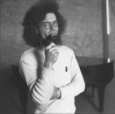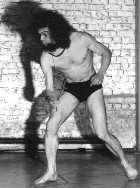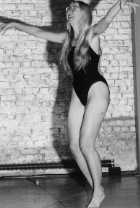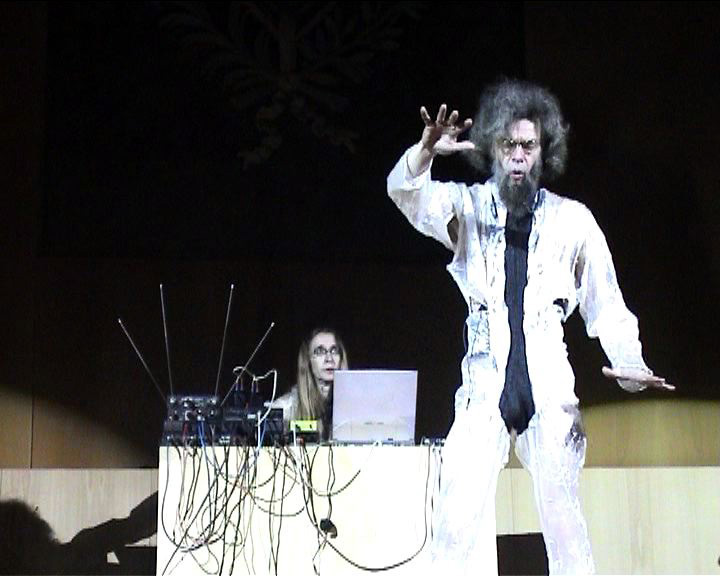

Songbook
Godfried-Willem Raes
1995-2003
Introduction
As the title suggests, this work is a book of 'songs'. Although 'song'
in this case, does not refer to the classical or popular song-tradition.
It is more a collection of abstract, but suggestive sound-poetry, appealing
in a seducing manner to anybody's imagination. Songbook begins with an
introductory commentary on the work itself. (INTRO) Eventually the natural
speaking voice gradually turns into an enstranged voice, and when the
composer himself is going to give a highly scientifical dissertation on
the work (RETOR), the invisible equipment transforms his speech into a
'jabbertalk' that would make Lewis Carrol envious.
Turning necessity into virtue , he more and more uses a singing voice,
which now undergoes pitch transposition (PITCHING), at first accompanied
by long lyrical synthesizer tones and subsequentially by a complete chorus
(CHOIR). Extremely fascinating in this part, with the very suitable title
'Choir', is the contra-bass voice that will send a involuntary shiver
down any woman's spine. Concluding this first chapter it is now also the
timbre of the voice that is influenced by body movements, (EQ's), which
produces remarkable results especially with hisses.
In the next chapter Moniek Darge tells you an imaginary fairy-tale (STORY),
consisting of abstract sounds, movements and mimickry, allowing you complete
freedom of imagination. Is it a bird rocketing through the sky or is it
the shuffle of a monster underneath your bed? When her voice abruptly
dies in her throat (DELTA-t) armwaving provides the releasing echo, which,
re-shaped into a bizarre chord-conglomerate, accompanies a strange song.
Each spot on the playing field harbours different sounds (ARP).
An inexhaustible play of reverberation, vibrato and voice-doublings. Now
the room will shrink to the size of a claustrophobic egg, then it will
grow to become an awesome resonating cathedral (VERBS). All depends on
the performer's motions. Including the localized chords accompanying Godfried-Willem's
voice (HARMS) and the shamanistic trance-inducing dance with its obsessive
rhythms and repetitions. (SHAMAAN).
Suddenly Poseidon arises, surrounded by subaquatic sounds and exploding
air bubbles (GURGLE). The water squirts and splashes. The porpoise-chariot
goes wild. The computer even replies to whistling (SPECTIM). But in the
end quietude returns in all of its grandeur (LINK). Both performers influence
each other vocally, via the machine, while the motions also still modulate
the sounds. A magical play of harmonically merging voices slowly dies
away attempting perfect unity.
Songbook uses, just like our previous production, 'A Book of Moves', a
radarsystem, invented and built by Godfried-Willem Raes. Three transducers
are placed on the floor, and a fourth one is hanging above the middle
of the performance area. One is emiting ultrasonic waves, the three others
receive them and send them to a series of analog and digital computers.
When the performer moves between the emiter and receivers the ultrasonic
wave will be reflected at a frequency different from the original. The
difference between the two frequencies provides valuable data about the
motion. Thus speed, acceleration and mass can be translated by the computers
into musical parameters. During the performance of Songbook, both performers
wear wireless microphones. Without physical connection to the discretely
set-up equipment, they manage to modulate their vocal output by body-movements.
This obviously provides an intriguing and for the layman rather magical,
haunting representation.
Moniek Darge

Program Notes
INTRO (performer: Moniek Darge)
The spoken introductory comments to the songbook can become a part of
the 'Songbook' in their own right, if this piece is performed as the start
of a given performance. At the end of this indroduction the speach becomes
unintelligible and leaves only the rethoric of vocal utterance and gesture.
RETOR (performer: Godfried-Willem Raes)
 Here acceleration of movement is directly mapped on the pitch deviation
applied to the vocal input of the performer. Thus the performer can deliver
his oratio, whilst stressing the flow of his thoughts through appropriate
body movement.
Here acceleration of movement is directly mapped on the pitch deviation
applied to the vocal input of the performer. Thus the performer can deliver
his oratio, whilst stressing the flow of his thoughts through appropriate
body movement.
PITCHING (performer: Godfried-Willem Raes)
Every human when speaking normally, has an absolute and invariable pitch
around which all his speach seems to be centered. Normal rethoric consists
in one part in the functional deviation from this 'tonal' center, further
in the dynamic curve -or enveloppe- of his speaking and last, in the gestures
-small or large- that accompanies the speach. In this song, all these
elements of vocal rethoric are amplified: pitch deviations are enlarged
and at the same time modulated by the movement. Hence, 'Pitching' became
a caricature of rethoric. The addition of one single sampled sound is
purely ornamental. Its pitch however, is a function of the vocal pitch
produced by the voice.
CHOIR (performer: Godfried-Willem Raes, Joachim
Brackx or Karin De Fleyt)
Here the attempt was to compose a choral composition to be performed by
a single voice. The number of voices in the choir -up to a maximum of
16 voices- is a function of movement parameters, in this case of moving
body mass. Movement velocity is mapped on temporal (delay) parameters,
thus rendering a limited form of canonic polyphony possible. On standstill
of the performer, his voice is transposed a full octave downwards, thus
opening possibilities for the performance of a most impressive bass-solo
part.
EQ'S (performer: Godfried-Willem Raes, Joachim
Brackx or Karin De Fleyt)
This section is an attempt to map the shape of gesture in time -obtained
by performing a Fourier analysis on the movemental signals- on the spectral
distribution of the audio channel fed by the vocal input. Easier said:
a movement controlled equalizer.
STORY (performer: Moniek Darge)
This piece uses a pseudosemantic fairy tale. It fakes narrative, yet movement
can be used freely by the story-teller to modulate the speaking extensively.
DELTA-T (performer: Moniek Darge)
 Vectorial velocity is mapped here on three different delay- parameters.
Real-time controlled canonic and rhytmic forms become thus possible.
Vectorial velocity is mapped here on three different delay- parameters.
Real-time controlled canonic and rhytmic forms become thus possible.
ARP (performer: Moniek Darge)
Melodic and harmonic patterns are mapped on the vectorial position of
movement detection. Movement is not only mapped on pitch- and timbral
shifts, but on the temporal structures as well.
VERBS (performer: Moniek Darge)
The size and thus the consequent acoustical properties of the space becomes
a function of whether this space gets occupied by moving or not. The limits
of the world are the limits of my action, exemplified.
HARMS (performer: Joachim Brackx or Karin De Fleyt)
This song is the vocal version of 'Topoi' in 'A Book of Moves'. Close
harmony structures are mapped on the results of a topological analysis
of movement positions. The harmony treatment is in four independent voices.
SHAMAN (performer: Godfried-Willem Raes)
A shamanistic dance, a ritual maybe. Rythms of movement are detected and
used to trigger exotic percussion sounds. The voice is sampled in real
time and that sample, on playback, gets modulated through the scenic actions.
GURGLE (performer: Godfried-Willem Raes)
Here the possibilities of realtime DSP transformation of vocal input are
pushed to an extreme: parametric filters, phase modulation, pitch modulation,
time modulation and feedback modulation are used simultaneously. Think
of Tina Turner in a submarine filled with nitrogen during a heavy deep-sea
storm.
SPECTIM (performer: Godfried-Willem Raes)
Here no vocal sound but rather the performers whistling is used as sound
input. The spectrum of the global movement is mapped on the fivefold time-shifts
between input and output.
LINK (performers: Moniek Darge, Joachim Brackx,
Godfried-Willem Raes)
For this song, two vocal performers are used. The pitches of the one voice
determine and change the pitches of the other, whilst the pitch of the
first is modulated by the movements of the latter. Thus both performers
are intimately connected and interdependent.
Technical specifications
1. Audio-equipment list
- 2 channel loudspeaker system on stage, power rating: minimum 300 watt/channel
- Stereo line-amplifier with balanced XLR-inputs. (0dB/600 Ohms). This or these amplifiers should be silent (no moving parts such as fans). We do not require a mixing board nor microphones
- Long cables (Balanced XLR) to connect our outputs to the amplifier inputs
- Cables to connect loudspeakers and amplifiers properly
- If possible, a very large microphone boom-stand (height: 4 meter, boom length > 2 meters)
- This production uses wireless microphones and true diversity receivers. The frequencies we use are 181.000MHz, 179.400, 180.675, and 182.900MHz. These frequencies should not be used by any other piece of equipment around
2. Lighting equipment
- Light board with a minimum of 12 separate circuits and 12 theatre spotlights
- 2 or 3 blue filters with frames to fit the spotlights
3. Stage and other requisites
- Required free space on the stage: 5 m x 5 m, free height: minimum 3.20 m
- Small table: ca. 1m x 70cm, height 70 - 80 cm
- Small bench or chair without rest
- Dressing room reachable from the stage
Booking information
Logos Foundation Productions
c/o Moniek Darge
Kongostraat 35
B-9000 Gent
Belgium
tel.: +32 9 223 80 89
fax.: +32 9 225 04 34
e-mail: moniek.darge@logosfoundation.org

Photo: Io, LEM-Festival Barcelona, oct.2003.
| Back to Logos Projects | Back to Logos Website |
Last update: 2003-11-23